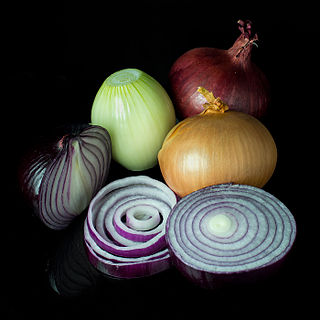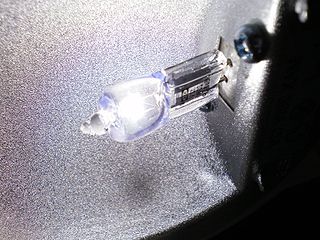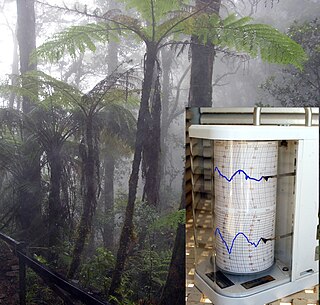
An electric light is a device that produces visible light from electric current. It is the most common form of artificial lighting and is essential to modern society, providing interior lighting for buildings and exterior light for evening and nighttime activities. In technical usage, a replaceable component that produces light from electricity is called a lamp. Lamps are commonly called light bulbs; for example, the incandescent light bulb. Lamps usually have a base made of ceramic, metal, glass, or plastic, which secures the lamp in the socket of a light fixture. The electrical connection to the socket may be made with a screw-thread base, two metal pins, two metal caps or a bayonet cap.

An incandescent light bulb, incandescent lamp or incandescent light globe is an electric light with a wire filament heated until it glows. The filament is enclosed in a bulb to protect the filament from oxidation. Current is supplied to the filament by terminals or wires embedded in the glass. A bulb socket provides mechanical support and electrical connections.

The onion, also known as the bulb onion or common onion, is a vegetable that is the most widely cultivated species of the genus Allium. Its close relatives include the garlic, shallot, leek, chive, and Chinese onion.

In botany, a bulb is structurally a short stem with fleshy leaves or leaf bases that function as food storage organs during dormancy.

A halogen lamp, also known as a tungsten halogen, quartz-halogen or quartz iodine lamp, is an incandescent lamp consisting of a tungsten filament sealed into a compact transparent envelope that is filled with a mixture of an inert gas and a small amount of a halogen such as iodine or bromine. The combination of the halogen gas and the tungsten filament produces a halogen cycle chemical reaction which redeposits evaporated tungsten to the filament, increasing its life and maintaining the clarity of the envelope. This allows the filament to operate at a higher temperature than a standard incandescent lamp of similar power and operating life; this also produces light with higher luminous efficacy and color temperature. The small size of halogen lamps permits their use in compact optical systems for projectors and illumination. The small glass envelope may be enclosed in a much larger outer glass bulb for a bigger package; the outer jacket will be at a much lower and safer temperature, and it also protects the hot bulb from harmful contamination and makes the bulb mechanically more similar to a conventional lamp that it might replace.

Lilium is a genus of herbaceous flowering plants growing from bulbs, all with large prominent flowers. Lilies are a group of flowering plants which are important in culture and literature in much of the world. Most species are native to the temperate northern hemisphere, though their range extends into the northern subtropics. Many other plants have "lily" in their common name but are not related to true lilies.

Tulip mania was a period in the Dutch Golden Age during which contract prices for some bulbs of the recently introduced and fashionable tulip reached extraordinarily high levels and then dramatically collapsed in February 1637. It is generally considered the first recorded speculative bubble. In many ways, the tulip mania was more of a hitherto unknown socio-economic phenomenon than a significant economic crisis. Historically, it had no critical influence on the prosperity of the Dutch Republic, the world's leading economic and financial power in the 17th century. Also, from about 1600 to 1720 the Dutch had the highest per capita income in the world. The term "tulip mania" is now often used metaphorically to refer to any large economic bubble when asset prices deviate from intrinsic values.

Scallions are vegetables of various Allium onion species. Scallions have a milder taste than most onions. Their close relatives include garlic, shallot, leek, chive, and Chinese onion.

The olfactory bulb is a neural structure of the vertebrate forebrain involved in olfaction, the sense of smell. It sends olfactory information to be further processed in the amygdala, the orbitofrontal cortex (OFC) and the hippocampus where it plays a role in emotion, memory and learning. The bulb is divided into two distinct structures: the main olfactory bulb and the accessory olfactory bulb. The main olfactory bulb connects to the amygdala via the piriform cortex of the primary olfactory cortex and directly projects from the main olfactory bulb to specific amygdala areas. The accessory olfactory bulb resides on the dorsal-posterior region of the main olfactory bulb and forms a parallel pathway. Destruction of the olfactory bulb results in ipsilateral anosmia, while irritative lesions of the uncus can result in olfactory and gustatory hallucinations.

A chandelier is a branched ornamental light fixture designed to be mounted on ceilings or walls. Chandeliers are often ornate, and normally use incandescent light bulbs, though some modern designs also use fluorescent lamps and recently LEDs.

Psychrometrics, psychrometry, and hygrometry are names for the field of engineering concerned with the physical and thermodynamic properties of gas-vapor mixtures. The term comes from the Greek psuchron (ψυχρόν) meaning "cold" and metron (μέτρον) meaning "means of measurement".
The Phoebus cartel existed to control the manufacture and sale of incandescent light bulbs. They appropriated market territories and fixed the useful life of such bulbs. Corporations based in Europe and America founded the cartel on January 15, 1925 in Geneva. They had intended the cartel to last for thirty years. The cartel ceased operations in 1939 owing to the outbreak of World War II. The cartel included manufacturers Osram, General Electric, Associated Electrical Industries, and Philips, among others.

A compact fluorescent lamp (CFL), also called compact fluorescent light, energy-saving light, and compact fluorescent tube, is a fluorescent lamp designed to replace an incandescent light bulb; some types fit into light fixtures designed for incandescent bulbs. The lamps use a tube which is curved or folded to fit into the space of an incandescent bulb, and a compact electronic ballast in the base of the lamp.

Illuminations are secular Autumn festivals of electric light held in several English cities, towns and villages, in particular:

A festoon is a wreath or garland hanging from two points, and in architecture typically a carved ornament depicting conventional arrangement of flowers, foliage or fruit bound together and suspended by ribbons. The motif is sometimes known as a swag when depicting fabric or linen.

The wet-bulb temperature (WBT) is the temperature read by a thermometer covered in water-soaked cloth over which air is passed. At 100% relative humidity, the wet-bulb temperature is equal to the air temperature and it is lower at lower humidity. It is defined as the temperature of a parcel of air cooled to saturation by the evaporation of water into it, with the latent heat supplied by the parcel. A wet-bulb thermometer indicates a temperature close to the true (thermodynamic) wet-bulb temperature. The wet-bulb temperature is the lowest temperature that can be reached under current ambient conditions by the evaporation of water only.

Apoda limacodes, the festoon, is a moth of the family Limacodidae. It is found in Europe. The wingspan is 20–30 mm. The moth flies in June and July in Belgium and the Netherlands.

The Albany Bulb is a former landfill largely owned by the City of Albany, in California. The Bulb is the west end of a landfill peninsula jutting west from the east shore of San Francisco Bay. The term "Bulb" is often used to refer to the entire peninsula, which includes the Albany Plateau, north of Buchanan Street at its base; the high narrow "Neck," and the round "Bulb." The Bulb is part of the City of Albany, and can be reached via Buchanan Street or the Bay Trail along the east side of San Francisco Bay.
Festoon (1951–1973) was a British Thoroughbred racehorse and broodmare, best known for winning the 1000 Guineas in 1954 and setting a world record when being sold at auction later that year. In a racing career which lasted from autumn 1953 to July 1954 the filly ran seven times and won three races. After winning her only race as a two-year-old, Festoon won the Classic 1000 Guineas over one mile at Newmarket Racecourse the following spring. She failed to stay the distance in The Oaks but returned to one mile to win the Coronation Stakes at Royal Ascot and finish third against colts in the Sussex Stakes at Goodwood. She was then retired to stud where she produced several winners.

Bulb Energy Ltd., trading as Bulb, is a privately financed energy supply company operating in the United Kingdom, Texas, Spain, and France. Bulb is based in London. Bulb began trading in August 2015, buying and selling electricity and gas to supply domestic properties. It is one of over 70 smaller energy companies competing with the "Big Six energy suppliers" which dominate the UK market. Bulb competes on price, offering a single variable tariff. It supplies 100% renewable electricity and 100% carbon neutral gas. Attracting venture capital, Bulb runs at a financial loss while achieving rapid growth in customers.
















